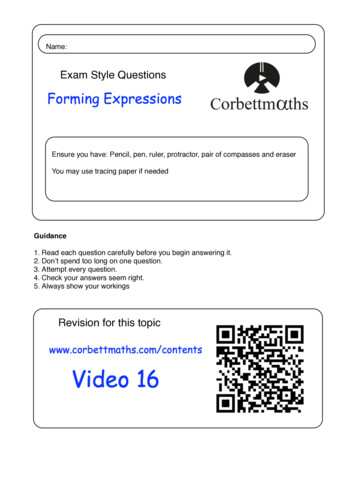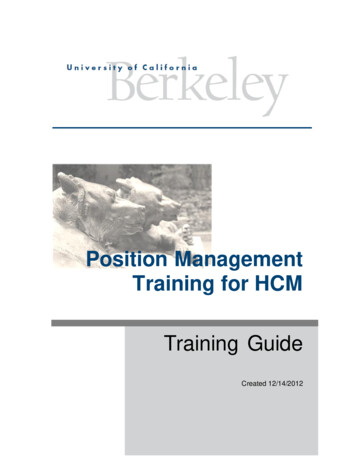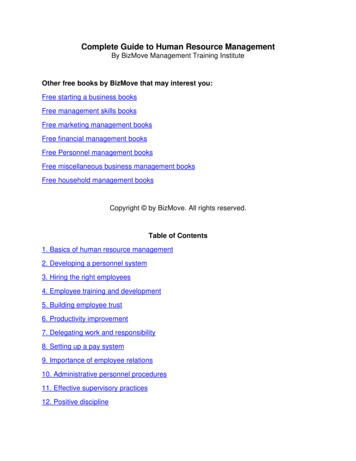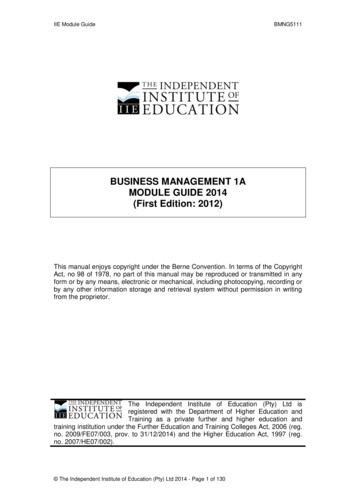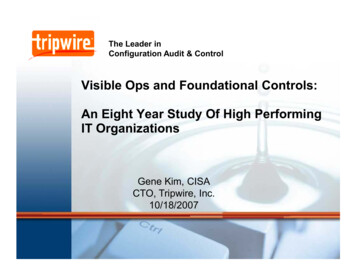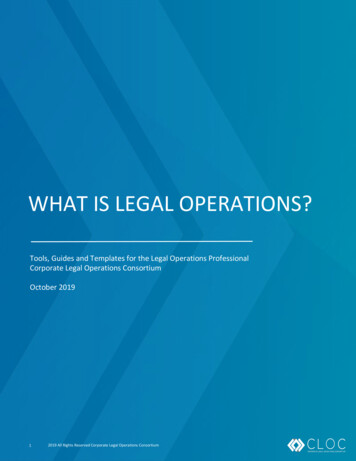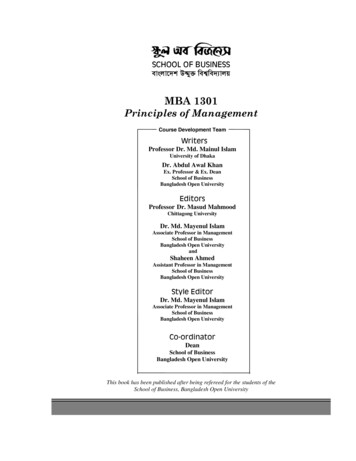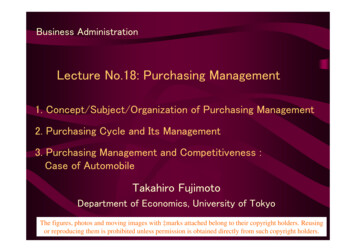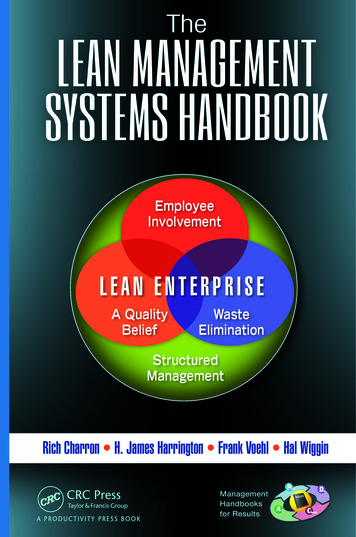
Transcription
Canteen managementEffective managementRole of the school councilGeneral business structure of canteensStock managementFinancial managementStaff and volunteersPromotion and marketingCANTEENMANAGEMENT
› Effective management› Role of theIn addition to providing the schoolcommunity with nutritious and affordablefoods, the canteen should be based on goodmanagement practices and be financiallyself-sustaining.Experience shows that, with good managementand marketing practices, a canteen can providehealthy foods and also be financially viable.The school canteen is a small business. Like anybusiness, it requires good management practicesto be efficient and successful. Effective canteenmanagement requires that: everyone involved knows its goals andobjectives and is familiar with its policiescanteen staff and committee develop animplementation plan to achieve policy goalsday-to-day operational procedures arestructured and enforcedstaff are adequately trained and supervisedstaff carry out efficient stock management,accounting and financial proceduresstaff are familiar with and comply with relevantlegal requirements regarding food safety andoccupational health and safety standards.school councilThe school council has, through theEducation Act 1958, the authority tooperate a school canteen.This authority can also be delegated to a clubor association that is not a subcommittee of theschool council, or it can be sub-leased to a privatecontractor under a licence. This licence is obtainedfrom the Department of Education & Training.The school council oversees the operation of theschool canteen, including its policies, employmentof staff, the disbursement of any profits and therecoupment of losses. The day-to-day operationsof the canteen are managed either by a paidworker or a volunteer. School councils usually forma canteen committee to manage canteen issues.All profits from the canteen are transferred to theschool council. Income from the canteen mustbe adequate to meet expenses incurred includingprovision for staff superannuation, sick leave,annual leave and other benefits and depreciation.If a school canteen is sub-leased to a privatecontractor, the school council should ensurethat the contract specifies that food be soldin accordance with the ‘Go for your life’ HealthyCanteen Kit – Food Planner and the DietaryGuidelines for Children and Adolescents inAustralia. It should also ensure that the operation(including stores, stocktaking, trading, profitand loss statements) of school canteens andother school food services is consistent withthe information provided in section 7.17 of theVictorian Government Schools Reference Guide.Many school councils are now recognising that animportant aim of the canteen, in addition to beingfinancially viable, is to provide nutritious foodsand promote healthy eating. This aim should beacknowledged in the canteen policy.Healthy Canteen Kit – Canteen Manual I 29
› General businessstructure of canteensSchool canteens may operate under a varietyof management structures, depending onthe individual characteristics and needs ofthe school. Most canteens in schools are rununder the direction of, and are accountableto, the school council. Schools may decideto provide a food service to students inseveral ways.Scenario 1: Full-time paid canteen managerplus paid staff and/or volunteersThe canteen manager is present at all times andtheir work is supported by paid staff and possiblyvolunteers.Scenario 2: Part-time paid canteen managerplus volunteer staffThe canteen manager will attend the canteen inthe morning to allocate tasks to volunteer staff,and return in the afternoon to finish operations forthe day.Scenario 3: Fully staffed by volunteersThe canteen is staffed by a volunteer canteenmanager with volunteer staff. It may alternativelybe staffed by a group of volunteers, each of whomis rostered and responsible for the operation ofthe canteen on particular days.Scenario 4: External food services managementcompanyManagement of the canteen is contracted to anexternal food services management company,which is responsible for staffing the canteen.Scenario 5: External off-site catererSchools without their own canteens may orderfood from an off-site caterer, such as the localmilk bar, sandwich shop or canteen lunchspecialist caterer.When deciding a management structure forthe school food service, school councils shouldconsider the type and extent of the food servicethe school needs. For example, a small schoolwanting to provide a canteen service onceor twice a week may be able to do this withvolunteer support or external catering. However,a secondary school requiring a more extensivefood service, including breakfast, may need toemploy a full-time canteen manager.Formal management agreementA formal management agreement detailingthe terms and conditions of the managementstructure should be drawn up and signed by therelevant management parties, which will usuallybe the school council and principal, or the schoolcouncil or principal and private contractor.Management agreementsThe management agreement between the partiesshould state clearly how any profits made fromthe canteen are to be distributed. There are anumber of options that should be considered.The school council pays profits to the schoolfor inclusion in the annual school budget andexpenditure is in accordance with schoolpriorities established by the school communityin the school charter and plan. The school council pays profits to the schoolbut they are not included in the annual schoolbudget. The school and school councildetermine the use of profits together. Thisoption allows for some of the canteen profitsto be invested back into the canteen so thathealthy changes can continue to be made. External catering contractors pay a set annualpayment per head of student population or payan agreed percentage of profits back to theschool council. It is important that food services that areexternally contracted or ordered from off-sitebusinesses are involved in, aware of and followthe school’s canteen policy. It is a good idea tostipulate guidelines within the canteen policy,for example regarding nutrition and promotionof healthy foods, within contracts and tenderswith external caterers. Employing staffEmploying canteen staff is the role of the schoolcouncil with approval from the principal. Whenemploying paid and voluntary canteen staff, itis important to follow good staff managementprocedures:following the correct industrial award oragreement having a formal job description and interviewprocess drawing up an official employment contract providing a staff supervisor having a performance review process providing adequate training establishing a complaints resolution procedure.For more information on employment andmanagement of staff for school canteens,including job descriptions, pay rates, employerentitlements and relevant awards, contact theAustralian School Canteens Association. Contactdetails of the Association are provided in theresources section of this manual. 30 I Healthy Canteen Kit – Canteen Manual
› Stock managementHow do I choose a supplier?The following pointers should help you inselecting a good supplier. An ideal supplier:The purchase of goods is a significantcanteen expense and therefore it is criticalthat this process is organised and efficient.It is important to: buy products at the best pricebuy appropriate quantities ensure safe, high-quality products order at the appropriate time. Who should be responsible forordering stock?Only one person in the canteen should beresponsible for ordering stock, which includesfoods, drinks, packaging, utensils, first aid andcleaning materials. Ideally this will be the canteenmanager, or a person who oversees most of thecanteen and has the largest time involvement.Allocating this responsibility to only one personis important as it prevents confusion and overordering, maintains consistency and ensuresmaximum efficiency.Canteens generally return higher profits whenthey restrict the number of suppliers and rangeof stock. Restricting the number of suppliers can bebeneficial as it allows canteen staff to developmanagement rapport with a supplier. This can alsoresult in special services and treatment, such asdiscounts and better quality of service.Minimising the range of stock assists in reducingslow turnover items, which can lead to spoilage.It will also allow you to use employees andvolunteers with less training given there are lessproducts to work with.Both of these practices will also result in moreefficient ordering with fewer orders needing tobe placed. is located locallyhas been recommended by other school canteensdelivers frequently, and will do so at aconvenient and suitable time for the canteendelivers stock in good condition, for exampleice-cream which is always frozen and fruit andvegetables which are always freshdelivers stock with the maximum shelf lifefollows appropriate storage, handling andfood safety requirements, such as adequaterefrigeration for chilled and frozen goods andshade and cover for fresh produceuses adequate packaging and handlingprocedures to ensure products are not damagedoffers an adequate range of productscommunicates well, keeping you informed ofprice changes, specials and product availabilityoffers competitive prices, as well as specials,discounts and incentivesoffers taste-testing opportunities or freesamples to trialprovides free promotional material in line withyour healthy canteen policy, such as posterspromoting healthy food productsoffers incentives, such as equipment rewardsoffers convenient and acceptable paymentprocedures, including method of payment andsettlement terms.HINT: Never select food or drink productsthat fail to reflect nutrition standards detailedin the canteen policy even if the supplier canoffer a lucrative deal, such as bargain pricesor equipment rewards.It is important to ensure that when minimising therange of stock in a canteen the range and varietyof nutritious foods, such as fruit and vegetables,is not reduced.Healthy Canteen Kit – Canteen Manual I 31
When to orderIt is important to maintain the lowest level of stockwhile at the same time having sufficient stock touse or sell. This reduces the risk of stock spoilingwhile in storage and also allows the canteento potentially be earning interest on money inthe bank instead of invested in stock sitting onshelves. It is also important to aim to have as littlestock as possible left over by the end of term toprevent spoilage over term holidays.How often your canteen needs to order stock willdepend on:how long it takes for the supplier to deliverthe order how regularly your supplier delivers – ruralschools or canteens using infrequent suppliersmay need to order products with a longershelf life the shelf life of the product – order lessitems more frequently to reduce wastageof perishable stock and aim to use fresh fruitand vegetables by the end of the week toprevent spoilage and decrease in quality overthe weekend storage space – this will vary according toseasons, for example refrigeration will be usedmore during warmer weather, so more regularordering of chilled items may be requiredat this time.Check the stock currently in the canteen. By usingan ordering list containing information on eachsupplier and their products, you can quickly viewcurrent stock and record what items need to bereordered. Keep a record of all orders and notewhen it was requested. When determining how much stock to orderfor your canteen, it is important to take intoconsideration the following: whether individual products are selling wellwhether your supplier is offering discounteditems and sales on products you usually stockany changes in the canteen menupopularity of certain items due to seasonalchangesspecial days, awareness weeks or culturalevents that might affect the types of foodsbeing sold and boughtupcoming special events and functions, suchas open days and sporting days, which mayaffect the sales figures for those daysadditional catering requirements such asproviding for committee meetingsclass excursions that may result in eitheran absence of lunch orders or the need foradditional cateringclass absenteeism, especially during key timessuch as Year 12 pre-exam period, or when yearlevels are located at alternative campusesfor a termpublic holidays and curriculum days where thecanteen is closed term holidays. HINT: Stock orders for special events shouldbe kept separate from the stock order tally forcanteen sales. If not, the mark-up schedulefor the canteen will be incorrect, as productsordered have not actually been sold throughthe canteen.Receiving stock Check the delivery docket and supplier’s invoiceagainst the order placed.Check for price increases and update thesupplier ordering list. Don’t forget to adjust thecanteen selling prices accordingly.Check the quantity and quality of stock, forexample whether refrigerated products areadequately chilled or frozen.Ensure that products are intact and notdamaged.Check use-by dates.Put chilled or frozen products awayimmediately.When restocking refrigerators and shelves,place the new deliveries at the back to ensurethat older stock is used first.Using stockProducts approaching their use-by dates mayneed to be used up quickly to prevent wastage,especially before weekends and term holidays.Strategies to use up stock quickly include:reducing the price of slow-selling stockintroducing a recipe of the week to use upingredients offering specials including products or fresh fruit in meal deals.For more ideas on turning stock over quickly, referto Promotion and marketing on page 38. Stocktaking should be done on a regular basisso that the canteen can account for all stock,including items which have been sold ordiscarded.HINT: Increase the turnover of short-shelflife products by extending hours of operation(without necessarily increasing the cost ofoperatio
having a formal job description and interview process drawing up an official employment contract providing a staff supervisor having a performance review process providing adequate training establishing a complaints resolution procedure. For more information on employment and management of staff for school canteens,
